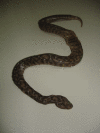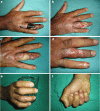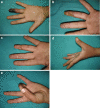The management of pit viper envenomation of the hand
- PMID: 18780013
- PMCID: PMC2584225
- DOI: 10.1007/s11552-008-9114-2
The management of pit viper envenomation of the hand
Abstract
Snakebites are common among the rural population of developing countries. The severity of venomous snakebites depends on several factors, including the location of the bite, the amount of venom injected, and the effectiveness of the initial therapy. Snakebites frequently occur in the extremities with approximately two thirds of envenomations occurring in the upper extremities. In this study, we presented 12 cases of hand reconstruction after Vipera snakebites and discussed how to minimize functional loss and maximize hand rehabilitation. Twelve patients bitten by Vipera between 2001 and 2006 were included in this study. Groin flaps were performed in three cases, full-thickness grafts in two cases, thenar flaps in three cases, and cross finger flaps in three cases. With medical management, spontaneous healing occurred in one case. We prefer to use flaps on the volar site of the hand and, if the bone is not exposed, full-thickness grafts on the dorsal site of the hand. We also recommend starting rehabilitation of the hand early.
Figures




Similar articles
-
Presentation and treatment of venomous snakebites at a northern academic medical center.Am Surg. 2003 May;69(5):445-9. Am Surg. 2003. PMID: 12769221
-
Suspected Vipera palaestinae envenomation in three cats.Vet Hum Toxicol. 1999 Jun;41(3):145-8. Vet Hum Toxicol. 1999. PMID: 10349702
-
Snake bite: pit vipers.Clin Tech Small Anim Pract. 2006 Nov;21(4):174-82. doi: 10.1053/j.ctsap.2006.10.008. Clin Tech Small Anim Pract. 2006. PMID: 17265901 Review.
-
Venomics of Vipera berus berus to explain differences in pathology elicited by Vipera ammodytes ammodytes envenomation: Therapeutic implications.J Proteomics. 2016 Sep 2;146:34-47. doi: 10.1016/j.jprot.2016.06.020. Epub 2016 Jun 17. J Proteomics. 2016. PMID: 27327134
-
Management of Snakebites in the Upper Extremity.J Hand Surg Am. 2019 Feb;44(2):137-142. doi: 10.1016/j.jhsa.2018.06.016. Epub 2018 Jul 26. J Hand Surg Am. 2019. PMID: 30057221 Review.
Cited by
-
A Guide to the Clinical Management of Vipera Snakebite in Italy.Toxins (Basel). 2024 May 31;16(6):255. doi: 10.3390/toxins16060255. Toxins (Basel). 2024. PMID: 38922149 Free PMC article. Review.
-
Compartment syndrome of arm secondary to snake bite on hand: a case report.Ann Med Surg (Lond). 2024 Jun 4;86(8):4832-4835. doi: 10.1097/MS9.0000000000002253. eCollection 2024 Aug. Ann Med Surg (Lond). 2024. PMID: 39118675 Free PMC article.
-
The clinical significance and management of finger necrosis due to cobra bite in Vietnam.JPRAS Open. 2025 May 23;45:159-169. doi: 10.1016/j.jpra.2025.05.011. eCollection 2025 Sep. JPRAS Open. 2025. PMID: 40606575 Free PMC article.
-
Snake Bite Management: A Scoping Review of the Literature.Plast Reconstr Surg Glob Open. 2021 Apr 29;9(4):e3506. doi: 10.1097/GOX.0000000000003506. eCollection 2021 Apr. Plast Reconstr Surg Glob Open. 2021. PMID: 33936914 Free PMC article.
-
Comparison of Preclinical Properties of Several Available Antivenoms in the Search for Effective Treatment of Vipera ammodytes and Vipera berus Envenoming.Toxins (Basel). 2021 Mar 13;13(3):211. doi: 10.3390/toxins13030211. Toxins (Basel). 2021. PMID: 33805701 Free PMC article.
References
-
- None
- Alagözlü H, Aktaş C, Eren H. Acil servise başvuran zehirlenme olgularımızın analizi. [Article in Turkish]. Analysis of the patients with intoxication admitting to the emergency department. Medical Network Klinik Bilimler ve Doktor 2004;10:143–7.
-
- {'text': '', 'ref_index': 1, 'ids': [{'type': 'DOI', 'value': '10.1016/0041-0101(91)90007-E', 'is_inner': False, 'url': 'https://doi.org/10.1016/0041-0101(91)90007-e'}, {'type': 'PubMed', 'value': '1801327', 'is_inner': True, 'url': 'https://pubmed.ncbi.nlm.nih.gov/1801327/'}]}
- Al-Joufi A, Bailey GS, Reddi K, et al. Neutralization of kinin-releasing enzymes from viperid venoms by antivenom IgG fragments. Toxicon 1991;29:1509–11. - PubMed
-
- None
- Arıkan H, Kumlutaş Y, Türkozan O, et al. Electrophoretic patterns of some viper venoms from Turkey. Turk J Zoolog 2003;27:239–42.
-
- {'text': '', 'ref_index': 1, 'ids': [{'type': 'PubMed', 'value': '17124671', 'is_inner': True, 'url': 'https://pubmed.ncbi.nlm.nih.gov/17124671/'}]}
- Arikan H, Alpagut Keskin N, Cevik IE, et al. Age-dependent variations in the venom proteins of Vipera xanthina (Gray, 1849) (Ophidia: Viperidae). Turk Parazitol Derg 2006;30:163–5. - PubMed
-
- Basoglu M, Baran I. Türkiye Sürüngenleri, Kısım II, Yılanlar (Turkish Reptiles, Part II, Snakes). Ege Üniversitesi Fen Fakültesi Kitaplar Serisi No:81, sayfa 218, Bornova, İzmir, Türkiye. (İzmir Ege University Science Faculty Book Series, Bornova, İzmir, Turkey) [Article in Turkish] 1980;81:218.
LinkOut - more resources
Full Text Sources

